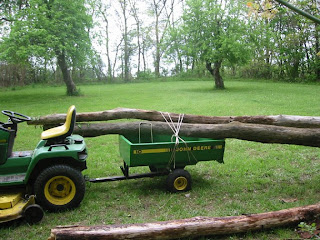Got an early start Saturday morning and spooked a doe with her fawn. I had my camera with me but the mama deer was so distressed I just passed by as quietly as possible. The little fawn was hunkered down in the grass trying to hide while the doe stomped and circled trying to decide if she should run from me or take me down. Nice reminder of how fortunate I am to live in such a beautiful place. Anyway, I started the day by stripping the cabin down to the floor and squaring up the decking as best as possible. Then I tacked down the boards with 16 penny nails. This is what happens to cheap fiberglass handled hammers when used to drive big nails through hardwood!
Once I secured the floor to the joists I lag bolted the short sill log to the decking to keep it from sliding around.
About eight hours later I had eight new notches cut and joined. I tried using a long groove cut on the first course above the sill and it did make a nice snug fit but pulling two angled cuts for six feet was really tough. On the remaining front side logs I pulled long straight cuts to flatten the sides that stack on each other. The back and front walls are tight but the sides have large gaps between courses. I'm thinking I will put small 3" diameter logs into those gaps just wedged and toe nailed in before chinking.
Ended the day burning the slash pile and roasting some pork chops over the fire. I was treated to a serenade of coyote howls and the familiar "Who Cooks For You" hoot of the Barred Owls.







































